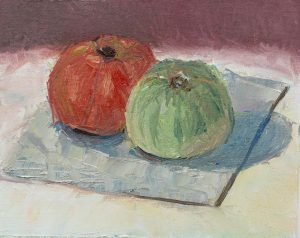14 Jan Why a Painting’s Not a Picture

A painting is not a picture of an experience, but is the experience.
—Mark Rothko
A 1950 marketing stunt made the phrase “Kodak moment” synonymous with the word experience, in the sense marketers use that word today.
An experience, marketers say, is a staged event.
A Kodak moment in the 1950s, consumers understood, was a staged event in a family’s life; and the photo—no matter its quality—a souvenir of the event.
In other words, a memento.
“Our job is to convince them that every picture is important,” Kodak’s marketing brief said at the time. “We must raise the value of memories.”

Ron’s Kodak Moment
It’s staging we so dislike about the selfie and the TikTok video, 2022’s versions of the Kodak moment.
They’re always so faux and so harrowingly inauthentic.
That’s why no one ever confuses a fine-art photograph—much less a painting—with a consumer’s Kodak moment, even though the professional photographer and the artist “stages” her subject (preferring to call it “designing” or “composing”).
But there’s a more important reason no one ever mistakes fine-art photos and paintings for consumers’ creations.
While equal in inauthenticity to the consumer’s creation, the fine-art photo and the painting aren’t pictures of an experience.
They are the experience.
Above: Two Tomatoes by Robert Francis James. Oil on canvas. 10 x 8 inches. Ron’s Kodak Moment by Ann Ramsey.
Hat Tip: Thanks to painter G.C. Myers for inspiring this post.
